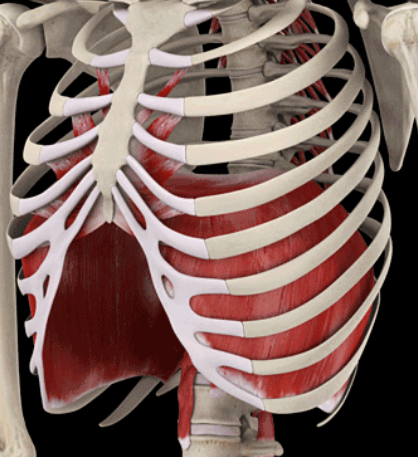Simple breathing exercise can restore normal pattern
- Mark J. Pitcher DC, MSc, EMT
- May 9, 2016
- 3 min read
Originally Published March 11, 2013 Vail Daily
To say breathing is important is a bit of an understatement. It is not just paramount for survival, but important for a whole host of other reasons. Altered breathing patterns can result in decreased athletic performance, increased pain, muscle imbalances and loss of core strength.
In normal efficient breathing, the ribs expand and the diaphragm contracts and lowers. Air is drawn into the lungs and the abdominal contents are pushed down and forward. The diaphragm is the most efficient breathing muscle and if not fully engaged, less air is brought into the lungs, respiration rate increases, blood pressure may increase and there is additional recruitment of the accessory breathing muscles.
Images courtesy of 3D4Medical.com
Since breathing is preferably a constant activity, overuse of accessory muscles in normal breathing can lead to overactive muscles and dysfunctional patterns.
A “weak core” is often blamed for decreased athletic performance and increased back pain. The inner core is like a corset of muscle and fascia that wraps around your torso closed at the top and the bottom by the diaphragm and pelvic floor. The strongest stimulus to enhance the activation of this inner core is the pressure created when diaphragm contracts.
When people diagrammatically breathe the belly is seen to rise. In contrast, chest or “apical” breathers tend to breath through their mouth versus their nose and their upper chest will be observed to rise instead of their lower ribs and belly. In these cases, the neck muscles can often be observed to aid in elevating the rib cage.
Stress response is probably the most common culprit for altered breathing patterns. When agitated in a flight or fight state, we are mentally and physically gearing up for increased demand or exercise. Heart and respiratory rates increase, muscles tense and accessory muscles of breathing are called into action. Luckily, this works the other way around and agitated states can be eased with breathing exercises. The benefits of mindful and diaphragmatic breathing have been known for centuries in many cultures. But this isn't alternative medicine, it is well-researched physiology.
There are other reasons for altered patterns. Many men and women consciously keep their abdominal muscles contracted to keep a flat belly, which makes belly breathing far more difficult. Significant inhibition of the diaphragm can also occur with pain after abdominal surgery. There is no better stimulus for re-programming movement patterns (and not ideal ones) than pain avoidance.
Many people may need specific coaching to help change their patterns, but there are some simple exercises that can helpful to restore normal patterns:
Lying on your back with knees bent, place one hand on your chest and one hand on your belly. Breathe in through your nose and out through your mouth. As you inhale, allow the hand on your belly to rise while keeping the hand on your chest still. Sitting with poor posture is not ideal for maximizing diaphragmatic breathing. Nevertheless, if you are reading this while sitting at your desk and think you might get some funny looks if you lay on the floor, go ahead, sit up straight and try this exercise right now. A few minutes of focused diaphragmatic breathing can yield noticeable change. Do enough cycles with your hands on chest and belly, until you have the pattern, and then continue for three minutes without your hands.






Comments